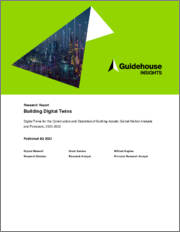
|
시장보고서
상품코드
1397882
건축용 디지털 트윈 - 빌딩 자산의 건설 및 운영용 디지털 트윈 : 세계 시장 분석과 예측(2023-2032년)Building Digital Twins - Digital Twins for the Construction and Operation of Building Assets: Global Market Analysis and Forecasts, 2023-2032 |
||||||
건축용 디지털 트윈은 건물의 설계, 시공, 운영에서 이제 막 그 틈새를 찾아가고 있습니다. 새로운 사용 사례 중 가장 주목할 만한 것은 아마도 디지털 트윈을 통한 고급 설계, 계획 및 시뮬레이션일 것입니다. 건설 중 작업자의 효율을 측정하거나 개조 중 HVAC 시스템의 효율을 측정하는 등 디지털 트윈의 데이터와 시뮬레이션 능력은 실수나 중복 작업을 피하고 건물의 미래를 위해 최선의 선택을 하는 데 매우 유용합니다. 디지털 트윈은 아직 초기 시장이기 때문에 성장에 몇 가지 장벽이 있습니다. 가장 중요한 것은 디지털 트윈이 유용한 명확한 사용 사례의 부족, 데이터 부족, 건물의 하드웨어와 소프트웨어 시스템 간의 비호환성입니다.
세계의 건축용 디지털 트윈 시장에 대해 조사했으며, 최신 동향, 촉진요인, 장벽 등 시장 과제에 대한 분석을 제공합니다.
KSM 24.01.03As buildings are designed, constructed, and occupied, they generate large amounts of data that can increase efficiency and reduce liability. Digital twins are proving effective in utilizing this data by helping designers communicate better with customers, construction teams communicate better with each other, and building operators better anticipate how changing conditions will have an impact on their assets. A digital twin is a digital replica of a real-world asset that offers a real-time reflection of the asset's status. For buildings, this looks like a three-dimensional model of a building's systems and architectural features, and its real-time status from connected sensors and devices.
Building digital twins are just beginning to find their niche in building design, construction, and operations. Of the emerging use cases, perhaps the most notable is digital twins' advanced design, planning, and simulation. Whether measuring a crew's efficiency during construction or the HVAC system's efficiency during a retrofit, the digital twin's data and simulation abilities are invaluable for avoiding mistakes and duplication of efforts, and making the best choices for the building's future. As a younger market, building digital twins face several barriers to growth. Chief among them are the lack of a clear use case in which digital twins are invaluable, poor data, and incompatibilities between a building's hardware and software systems.
This Guidehouse Insights study analyzes the global market for building digital twins. It provides an analysis of market issues, including emerging trends, drivers, and barriers. Global market forecasts, which extend from 2023-2032, are segmented by eight building types and five world regions.











